SocialCamp 2011: How Social Internet Networks Transform Russia's Social Action
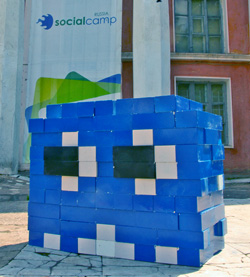 From 5 to 8 July, a conference "SocialCamp 2011" was held in Tver.
From 5 to 8 July, a conference "SocialCamp 2011" was held in Tver.SocialCamp was devoted to the topic of how social networks and other Internet resources can help public and charitable organizations. And, as the experience of the speakers showed, they significantly influence. Practically, social activity has reached a new level. And these are not just “journalistic” words.
The conference was held in the style of BarCamp , which the organizers translated into Russian as “Non-conference”. For some reason it seems to me that such a name will not take root, rather the Russian transcription Barkamp will be fixed. But not in terms of the essence!
')
This article is not about IT, but it is about how IT helps good things.
Denis Terekhov on the current state of social networks
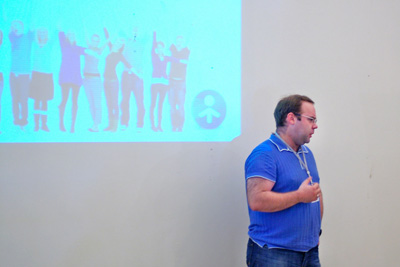
Denis Terekhov, the head of the Social Networks agency, although working mainly with commercial structures, set a good pace from the very beginning. His performance was emotional and persuasive. The brightest, perhaps, was an illustration of how important it is in our time to react correctly and promptly to events on the network.
Three examples:
- Gazprom and the construction of "Corn",
- Lukoil and the famous accident on Leninsky Prospect,
- RusHydro and the reaction to accusations of connivance.
The first two examples are about how wrongly the companies acted, what were closed from the dialogue with bloggers. They decided that 2% of the population did not decide anything. As a result, a clear public opinion was formed that it is not necessary to build a new building of GazProm in St. Petersburg, that this is bad and corruption. And people remember about Lukoil first of all about the accident at Leninsky, and only secondarily, that this is a fuel company.
A positive example of how to communicate with bloggers was demonstrated by the RosGidro company after the accident at Soyano-Shushenskaya GRES. As soon as there was an assumption that there were supposedly living people somewhere and no one is going to look for them, the management took a bold step: it invited bloggers to the repair site and paid them for travel. As a result, a sufficient number of positive topics appeared on the progress of the station restoration. Public attitudes were able to change.
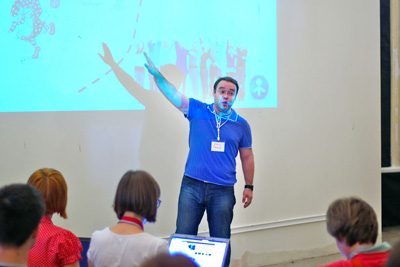
Another interesting detail that Denis told about: a new position appeared in large companies - a blog secretary. His duty is to monitor social networks and respond quickly.
On my question:
- So how do organizations behave when negatives appear on blogs? It is no secret that the negative spreads more actively than the positive.
Denis replied (the quote is not accurate):
- Only true. It is necessary to react quickly enough, not to abandon the development of events. And to answer as truthfully as possible. This is the only recipe.
Blue buckets
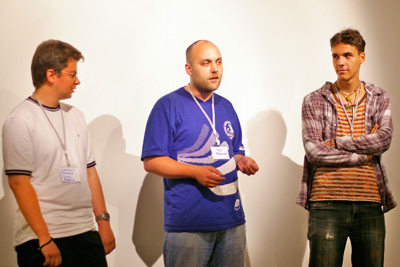
The next day, on July 6, three representatives of the “ Blue Pails ” arrived from Moscow: Peter Shkumatov, Danil Lindele, Dmitry Platonov. These guys performed without a presentation,
I am very sorry that I did not record their performance, so I will restore the main ideas from memory:
- Our community appeared only thanks to the Internet and social networks. 5 years ago this was not possible. And now the record appears on the network and spreads itself. In a few days, it receives hundreds of thousands and millions of views.
- To become a member of the blue buckets, it is enough to carry a camera with you and remove all the real violations. Spread them yourself, or send us.
- In general, there has already been a noticeable shift in the minds of drivers. People began to more actively protect their rights. If there is a clear mess on the road, many people passing by stop, ready to help.
- We have support from traffic cops. This refers to ordinary traffic cops. Because it too already got them, when they can make nothing with people with flashers. Recently there was a case when a traffic cop at the post was hit by such a machine is not ordinary people. There was a complicated leg fracture. And he was not given compensation, and they even said: "Sit down and shut up." We later helped to collect money for his treatment.
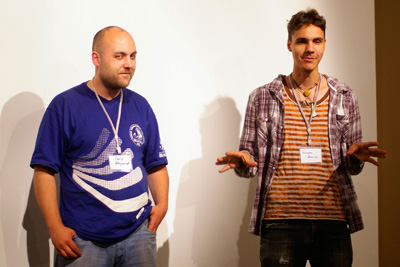
- We are absolutely horizontal organization. We have no major, secondary. Everyone contributes. When the authorities wanted to thwart our action and detained two, as it seemed to them, leaders, we still all got together and drove along a given route.
- We do not ask anyone for money. On the way, we invest our own. So I printed stickers for my money. To whom it is necessary, after the master class, approach, we will distribute to everyone.
- We do everything with humor and good mood. When they want to detain us, they simply don’t know where to find fault. We do not say - "overthrow the power" or something else. No, we are having fun, we are kidding. We go with buckets - well, it's funny!

- We do not have any political goals. Blue buckets will disappear in five minutes after all privileges on the road are canceled. In addition to traffic police cars, ambulance and firefighters.
This is so simple, while some whine: "In our country, there is no one, there is no other" - Blue buckets, or Artem Loskutov just take and do.
Artem Loskutov

Artem Loskutov , a well-known young artist from Novosibirsk, who invented the Monstration , and received the prize of the Ministry of Culture of the Russian Federation for it, performed on July 7th. He spoke very little about IT. To the question about which social networks it is necessary to disseminate information, he answered briefly:
- Yes, what's the difference? You can call and say by phone: guys, let's go to the Monstration!
But he himself continuously used the laptop, scribbled on Twitter and VKontakte . By the way, Twitter was generally very actively used at Kampa, but more on that later.
I recorded Artyom's speech, but the video was not of high quality, I will not post it. Better briefly write out some thoughts:
- Monstration baffles policemen and spectators in general. They do not understand these signals, this phenomenon of absolute “Nothing.”
- 80 people came to the first Monstration in 2004. In 2010, about two thousand. This year there were about 4,000 people.
- I do not know why Monstration is so popular. But I can make the assumption that Monstration simply does not have a clear positioning of the political. Now if they ask: "And you are from whom." And if they answer, say: "From the Communists," then that's all. The authorities know how to negotiate with any acting political force. And we did not fit anywhere.
- We did not coordinate the first Monstrations with the authorities. We were sure that we could just go outside on May 1 and take a walk with banners. And so they did. They went out on May Day with their slogans. One must understand that May Day is no longer a demand of the workers, but simply some kind of meaningless ritual. And such senseless things happen a lot. And it can be used.
- As to whether this is a political action, or art, or “just making a laugh”. No, it's not easy to laugh, at least I speak for myself. As for the political or artistic - now there is a blurring of the boundaries between these things. I am not interested in either pure politics or pure art.
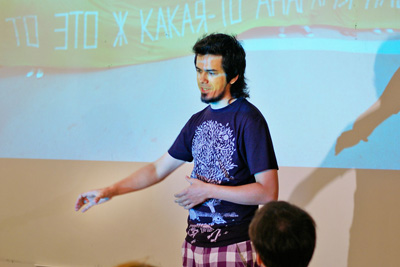
- There are no rules on Monstration, no censorship. Everyone writes what he wants. If someone writes a commonplace, then it just becomes not interesting. Well, someone wrote “Cho-cho, upyachka!” Well, I know where it appeared 4 years ago. Once the organizers of the Scorpions concert tried to cling to us. Came out with us with “I Love Scorpions” badges. Swore at them in the swearing, no one took pictures. Their stock failed.
- So far, I go to the city administration with the application myself. I would not mind if someone volunteered to help.
Artyom left the camp in the evening, and I was not able to find out his opinion on the construction of peckmen from bricks.
We build pakmenov

My idea of building monuments to the heroes of pixel games made of colored bricks could have remained an idea and did not advance either, if it were not for Social Camp. On July 7th, the Twain Party took place in the evening. Three in one: a concert, a performance, and a party. The organizers noticed my idea and offered to put part of the monuments in the evening right at the main entrance. I urgently phoned my brick makers, waited for confirmation from them that they were ready to support the action.
Here I want to make a small lyrical digression. About 10 years ago I participated in a public organization that specifically sawed grants. I saw enough of how people swear because of sharing of money, and was very disappointed. SocialCamp gave me confidence that you can participate in social movements. No, honestly.
When the bricks were brought in and it was necessary to start putting the Packmen out of them, I asked the organizers of Rostislav Volegzhanin and Darya Melissina:
- How are we going to organize people?
Rostislav answered without thinking:
- Very simple: let's go and start doing it ourselves. People will catch up.
And so it happened! We just started to unload the bricks, and then volunteers appeared. Apparently, this is an indispensable part of any voluntary and social movement - do not ask permission, act, set an example.
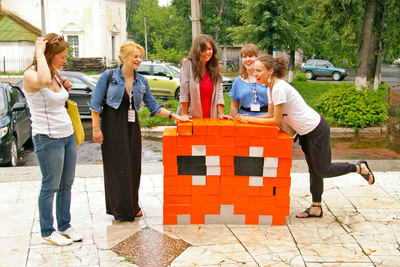
Paikmen, Inca and Clyde were laid in draft form without concrete. They looked gorgeous! They did not fold one red jellyfish, as it turned out that not all bricks were painted as it should. Of them folded something like a carpet. It turned out quite an art object, causing a smile. And many nostalgic for the times when the pixels were large.
Now we have experience, photos, trying to make the jellyfish's eyes a little bulging. And there are already 98% of colored bricks. I hope we still build our jellyfish really on the solution.
Already at night thinking - to disassemble or not to disassemble the Peckmen? And they decided to set up a social experiment: let's leave it as it is, see how many bricks are stolen. In the morning not a single brick was taken away! Here it is, the great power of modern art. The next day, the participants helped me to remove the brick, for which I am grateful.
Yandex money

On July 8, Natalia Khaitina from Yandex.Money held a master class. We sat in the lowest and darkest hall, the lighting was more modest than at the school disco of the 70s: a pair of spotlights on Natalia and a projector on the wall.
Here, the BarCamp principle was most clearly manifested - communication was in both directions, Natalya answered more questions than just reported on a piece of paper. Other participants talked about their experiences. It was all pretty helpful.
At 12 o'clock the whole program is over. The farewell passed warmly. When the organizers asked where they would like to meet next time, they answered:
- Let's here in Tver.
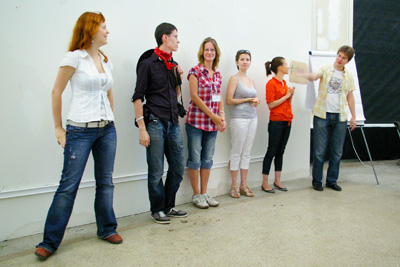
This is largely due to the fact that the building of the River Station is now under the direction of the Tvertsa Center for Contemporary Art. Here is a kind of very free atmosphere. But the building itself is interesting in architecture, both outside and inside. In any room here you feel comfortable.
When we cleaned the bricks into the building, a wedding arrived at the River. We felt a sharp contrast between the audience, which is trying to look beautiful, and us. All sokamperi looked like some kind of hipan.
Twitter on SocialCamp
Twitter was used not just actively, but megaactively. In the main hall, a live tape was broadcast on the wall, and many preferred to communicate with each other through Twitter.
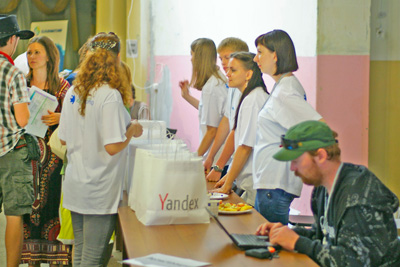
However, live communication was also enough. Many, probably, have already experienced this feeling: when you return from Europe to Russia, the smiling faces of prosperous Europeans give way to the irritable faces of our fellow citizens, who see everything as a catch. About the same feeling I experienced leaving SocialCamp.
Authorship
All materials are distributed under the license Common Creative. Please refer to the personal page of Vadim Galkin .
Source: https://habr.com/ru/post/124440/
All Articles